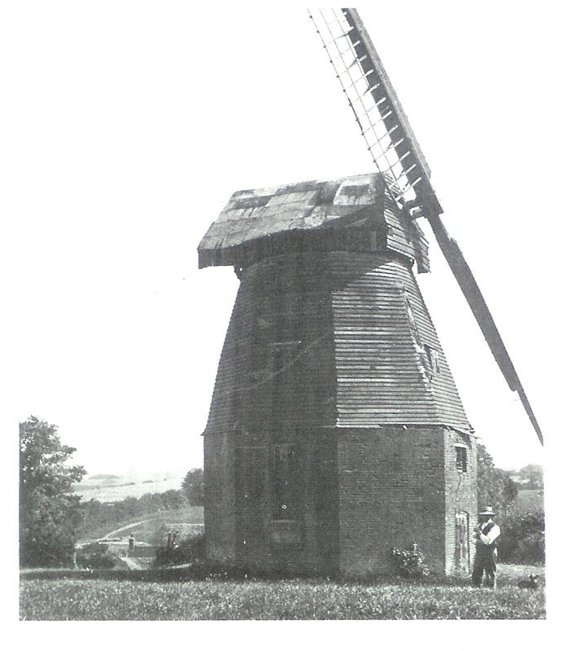 |
Wicken Bonhunt The Windmill at Wicken Bonhunt |
 |
| Wicken Bonhunt homepage |
A smock windmill stood on high ground at the north end of the village. Mill House is still there today facing the main road. Alongside the house a track ran about 170 yards up to the mill.
The 1777 Chapman and Andre map does not include the mill; however an earlier reference shows that John Headland a yeoman of Wicking insured a windmill standing in the parish in 1765. The mill was in the tenure of Thomas Wyman a master miller and the insurance value was £100 for the windmill and £40 for the contents.
The mill is describes as a substantial smock mill with two pairs of French stones and a flour mill which had the primitive feature of hand winding. In 1786, the freehold was offered for sale by Debden Wright of Newport. In 1796, the mill contents were insured for £60 by Thomas Nottage, shopkeeper, farmer and miller of Clavering. He was succeeded by James Pavitt of Clavering who insured stock and utensils for £30 in 1800. It has been suggested that the low values indicate that most of the contents belonged to the landlord. The Nottage insurance entry describes the windmill as ‘timber boarded and thatched’ and in Pavitt’s ‘timber built and thatched’. In neither case is there reference to brickwork which was usual when there was a brick base.
Later photographs show the mill with a substantial two story brick base with a short and strongly battered octagonal smock frame set above. Raising the mill probably occurred in the mid 19th century when the whole wooden body would have been lifted 16ft. to allow for inserting the two lower floors.
Numerous millers are recorded: Joseph Thurgood in 1832 followed by Samuel who was made bankrupt in 1840. The 1841 and 1851 census are not specific about the mill, although Stephen Wisby aged 25 gives his occupation as miller. Later census records show the various households including:-
1861: John Grayston aged 62 was the miller who lived with his family at the Mill House. All three children are recorded as miller’s son or daughter indicating this was a family business.
1871: George Moore and family were living at the Mill House in 1871. Only one of the three children, Mary Ann aged 17 worked at the mill while her siblings found employment as a dressmaker and labourer.
1881: Zachariah Livings aged 65 was the Corn Miller living with his daughter Emma aged 20.
1891: George Moore had returned to Mill House as a retired miller. His daughter Mary Ann aged 38 had married Herbert Ruse – Master Miller. They had three children; Herbert 6, George 4 and Mark aged 1.
1901: Herbert and Mary Ann Ruse, now in their 40’s are shown as Master Miller, living on their own account or financially independent. Their 16 year old son Herbert is working as a miller’s apprentice.
The windmill was offered for sale as part of the Shortgrove Estate Newport in 1889, when the mill was let to George Moore on a yearly tenancy of £20. The sale catalogue describes the mill as ‘part brick and part timber built, having two plain sails, two patent spring sails, and two pairs of stones’. The mill was working until around 1905 by which time, steam driven machines had taken over. The photograph was taken around 1910 and shows the plain or common sails in an iron windshaft. The cap was straight-ridged, apparently covered with sheet metal, and minimally rounded near the base to follow the curb. The cap carried a petticoat at the sides with a rear overhang to shelter the large winding wheel.
The
mill was visited by Dr
Turner in 1921 who found the mill derelict, having last worked around
1905. The
windmill was demolished not long after.

Deborah Lowe, Wicken Bonhunt Recorder
